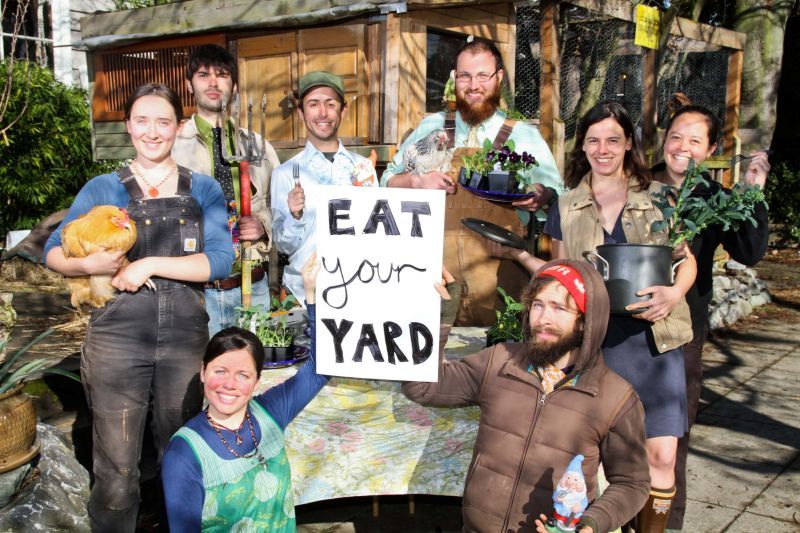By Lisa Watters-Lain, Arizona’s Garden Gal
The front yard of any house makes such an important first impression. Many homeowners lean heavily on a shrub border and a couple of trees to bring the landscape’s design together. What most people don’t consider, though, is that the front yard is often the sunniest spot in a landscape, which makes it the perfect spot to install a beautiful working farm: vegetable gardens thrive in lots of sun, and with careful planning, edible plants can play a starring role in a yard’s striking scenery.
“Hide them in plain sight” is the secret to a great-looking area that also adds to your harvest.
Many culinary herbs are direct descendants of our native plants and make for hardy landscape edibles. Low growing oregano, sage, and creeping rosemary knit the landscape together for a cultivated garden style. Most herbs are perennial and spread each year, so encourage them to grow throughout the landscape.
I consider attention-grabbing artichoke plants the superstars of the front yard edibles. With softball-sized purple flowers shown off against dramatic downy blue foliage, they make a bold statement. The designer in me likes the architectural structure of the whole plant, and because it’s a perennial, it’s practical, too: it comes back every year. If you like to eat artichokes, harvest the fruits before the color shows on the flower. Allow the artichokes to mature and bloom, and you provide family, friends and yourself an exuberant show!
Mint makes a superior container plant, but I prefer planting it by the driveway, especially at the low side where rain naturally runs. Mint flourishes under the extra moisture and, thanks to its dense roots, it helps prevent erosion. Chocolate mint can take over lush garden settings, so if it gets too aggressive, run it over with the SUV. Go ahead, abuse that mint; it will still produce those wonderful chocolaty leaves perfect for summer party teas!
Trees can be your greatest source of food. Not only do fruit trees bloom in the spring, provide shade in summer, and deliver great fall colors, but they also deliver an abundance of food in the landscape. Friends, along with the local food bank, will welcome the leftover harvest you simply cannot use. Or, dust off the canning supplies and use the entire bounty.
Some edibles develop better flavor with a bit of shade, so take advantage of the irrigation already plumbed to tree wells. Crops like lettuces, kale, peas, nasturtiums, radishes, and cabbages thrive under shaded conditions and look great in contrast to a stark tree well.
And be sure to nurture and protect your edibles so they can thrive and nourish you, too! Feed them and protect them from parasites and your garden will flourish.
Watters 7-4-4 All Purpose Plant Food is the secret to great-tasting edibles. Bring out the best flavors in the gardens with an application of this all-natural food at six-week intervals starting in spring. Herbs and vegetables thrive under the care of this locally produced plant food.
For the most part, insects do not care for the taste of herbal landscapes. In fact, herbs make great companion plants in the vegetable garden because they repel bugs. If you happen to spot huge green caterpillars on the tomatoes in mid-summer there is an easy organic solution: Watters Thuricide bug control knocks down summer insects but is safe enough to use on all edible plants. It really works and is a safer alternative to traditional pesticides.
To get you started, here are some ideas…
Combine these edible and non-edible plants for showy combinations that maximize the WOW! factor in your front yard:
Sage & Succulents show well together. Rosy Afterglow Chicks and Hen contrast beautifully year-round with sage, or Salvia officinalis, a tricolor variety with a mouth-watering culinary flavor.
Thyme & New Zealand flax create a dramatic impact. A mound of blue-green culinary thyme, or Thymus vulgaris, softens the upright foliage of the stiffer New Zealand flax, or Phormium. Thyme also pairs well with yucca, agave, and upright native grasses.
Purple Basil & Golden Thyme combine for a landscaper’s WOW! Golden lemon thyme is low growing with bright yellow leaves. When it’s planted with “Red Rubin” or “Siam” basil, the effect yells, “We know style!” Both bring great flavors to the kitchen. Although they look good in container gardens, try planting them directly into a driveway border.
Tomatoes in the front yard? Yes! I like to use small-fruited tomatoes, especially the sweet 100, yellow pears and golden sweet varieties. The clusters are extremely ornamental and their foliage doesn’t deteriorate at the end of the season like others. Plant tomatoes at the edge of raised beds and let them tumble over . . . very pretty. Plant tomatoes in a large cobalt blue pot, growing through a solar yellow cage with pink wave petunias spilling over the edges and you have a container garden that exhibits great taste, and tastes great, too. The style will be so stunning you can show it off right at the front door.
Landscaping with edible plants is easy with a little help. Bring a photo, iPad or smartphone to Watters Garden Center and let one of the many horticulturalists there help you with the planning. They can also provide extra resources like the best planting techniques for the area, as well as how to grow better tomatoes, grapes and more.
Until the next issue, I’ll be helping local gardeners plant more edible plants here at Watters Garden Center.
Lisa Watters-Lain can be found throughout the week at Watters Garden Center, 1815 W. Iron Springs Rd in Prescott, or contacted through WattersGardenCenter.com or FB.com/WattersGardenCenter.

